|
The Layout |
|
THE
currently existing completed trackage of the NORMANED RAILROAD provides for multi-train
operation on three levels by means of the following: |
- a point-to-point route between two major terminals (Despatch
and Christopher)
- continuous operation on two independent (inner and outer) loops
or one long run utilizing both loops and turn-arounds at both
terminals
- yard switching for freight and passenger trains at both Despatch
(6 tracks) and Christopher (4 tracks)
- complete steam engine servicing yard with 5-stall roundhouse and
turntable
- two diesel-servicing areas
- passing and storage sidings and numerous spur tracks serving
various industries
- a major interchange point at Genesee Junction
- a branch line to an isolated resort village
- a coaling dock and unit train capability
- four reversing loops and two turning wyes
- 57 manual and remote controlled turnouts (track switches) making
possible virtually any combination of track movements
|
|
 |
|
Although this track diagram is not drawn to any exact scale, the
overall layout size is 15 ft. x 24 ft. in dimension as indicated, and
the drawing is relatively and proportionally correct. The numbers with
arrows indicate the position and direction from which some of the
photographs in these pages were taken — they are keyed to numbers at
the start of the captions below the applicable pictures. It is
possible that similar references to some of the other illustrations
may be added in a future update. |
|
|
In addition, a fourth track level displays the TTCo. Trolley Museum,
while a fifth level is home to the “Old Salt” mine with a model
representation of the unique Brooks Ave. yard depot of the Rochester &
Southern Division of the Genesee & Wyoming RR Co., along with “Saltersville
Siding,” where the old folks sit and wait for the passenger trains of a
different time and place. These are both static displays or dioramas, but
the arrangement is changed from time-to-time, and both levels have track
carrying trains off into “tunnels to nowhere” (or to anywhere, depending
upon the magic of one's imagination).
|

|
The
Tiny Transportation Co. Trolley Museum’s lineup of streetcars and
cable cars on display on the NORMANED RR layout. Also visible in the
photo are the “Saltersville Siding” shelter on the upper level, and a
corner of the Despatch yard below. |
|
|
Although there are provisions for eight separate operators (or
engineers), the entire model railroad or any of its parts may be operated
from the Main Control panel by setting interlocking electrical switches for
the desired control routing.
 |
Our
first grandson, Danny Kennison (at age three), discovers the train
whistle button on the model railroad's auxiliary control panel -- placed
intentionally at “child height.” |
Play
value also was kept in mind in designing the present NORMANED RR Layout, with controls for most automatic and remote control operating
accessories being placed where younger model railroaders can reach them. |
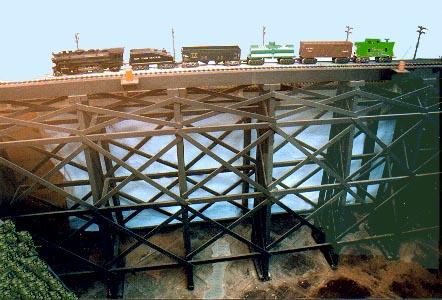
|
Co-founder Ned Wright's first train set, a 35-year-old Marx brand
powered by a die-cast 2-4-2 “Columbia” type locomotive, is featured in
the re-enacted ceremonial “first trip” over the “Giant Trestle” which
carries railroad traffic over the “Great Gorge” -- itself visible in
part beneath this large bridge on THE NORMANED RAILROAD. |
|
|
One of the featured attractions of the NORMANED is the Giant Trestle which spans the “Great Gorge” to connect Central City
to the main line. This bridge was constructed by the railroad's president
(that's me) entirely from scratch using prototype illustrations and scrap
lumber. It contains more than 250 individual pieces of wood, 7½ pounds of
nails, three pints of wood glue, and required 3½ pints of flat black paint
to finish; it will support the combined weight of four 200-pound men. This
trestle is 432 scale feet long and rises 148 scale feet above the floor of
the gorge.
|
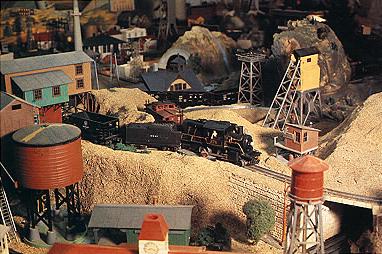
|
[4] After dropping off its caboose behind the turnout, the NN&T's
55-year-old 2-4-0 #276 backs an empty Atlas ore car under the Noma
Mine tipple for a load of coal. The Camelback engine - most ancient
loco on the NORMANED - was handcrafted on a pre-war Lionel chassis in
1947, the same year the NORMANED's founder graduated from high school.
The caboose was built from a limited edition D&H kit by Ambroid and
decorated for the NN&T. |
|
|
When
not being used to haul coal or transport mine or maintenance workers
(left), the "Tunnel Mountain" line serves as the route of the tourist
trolley (right). |
|
|
“Tunnel Mountain,” which rises behind Central City overlooking the
great gorge to the highest point on the layout, is another creation of the NORMANED's
“Norm,” who both designed and constructed it - and then made it work. The
mountain made it possible to model a railroad tunnel and two highway
tunnels, two shafts of the Noma (coal) mine, a point-to-point tourist
trolley line from Central City to the mountain's peak, and a
coal supply company which provides also a
servicing stop for hungry and thirsty steam locomotives. The proprietor
considers this project to be a companion to the Giant Trestle, and the
centerpiece of the model railroad.
|
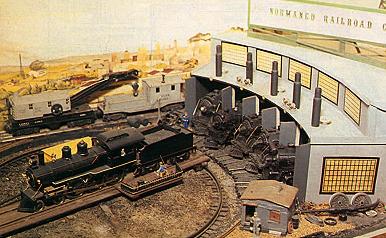 |
[5] A 4-6-0 ten-wheeler gets a last minute check-up after being
turned at the NORMANED RR's scratchbuilt five-stall roundhouse. Other
road engines (backed into their stalls to show off for the
photographer) sit proudly on display. |
|
|
The freelanced five-stall roundhouse (unusual on O-Scale home layouts)
also was scratch-built by the president using scrap materials; plans were
developed from old railroad photographs (pun intended), and some of the
“products” used in its construction might be “unseemly” enough to cause
proper young girls to blush - or others to laugh. The Arlington Hotel at
Panthorne, the “Old Salt” Mining Company building, and all of the control
panels also were designed and hand-made by the elder Mr. Wright (although
considerable assistance from others was necessary at times to get the
electrical wiring correct).
|
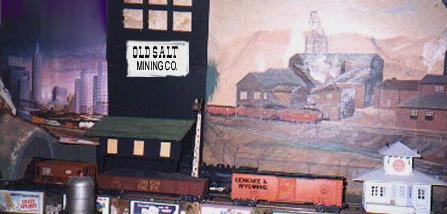
|
The
“Old Salt” Mining Co. diorama is a collage of elements of the mine’s
entrance and structures, and the Genesee & Wyoming System’s Rochester
& Southern Division Brooks Ave. yard depot, recalling the diversity
and growth of the service provided by the GNW RR during its 101-year
history. (The GNW was originally a 14-mile shortline serving the
now-abandoned Akzo Salt Mine in Retsof, N.Y., while the Brooks Ave.
yard has a long genealogy dating from 1913: go to
Inspirations.) |
|
|
A highly visible and distinctive miniature farm near the railroad line
into Bridgeport is the work of our middle child and daughter, Nita. She
perhaps tells its story best in her own words:
|
|
“This was my
biggest project that I can remember working on. I recall finding all
of the buildings and animals that I wanted to use for the farm. I
don't remember if it was Dad's idea, or a combination of both his and
mine for me to work on it, but I remember that it was a lot more fun
for me than the help I did with the industrial portion! I laid out all
of the pieces where I wanted them, spent time marking and measuring,
and finally gluing each piece in place. I remember spending a lot of
time on this project, and taking great pride in its completion. To
this day, I still think of the farm as 'my farm!'” |
|
|
And her farm
it is. Visitors who take a close look are all but amazed at the amount of
detailing this scene has - inside and outside the buildings, and in the
thoughtful use of the relatively small “acreage” provided for her use when
she built her farm. She has
also taken charge of maintaining the farm herself, and there is usually very
little that needs “fixin'” at Nita's farm! |
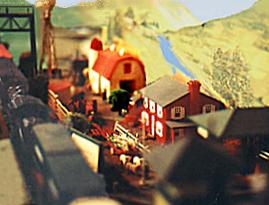 |
 |
|
“Nita's
Farm” lies in a narrow valley alongside trackage leading from Despatch
near the branch line to Bridgeport. A train (at left) passes the
farmhouse, barn, and assorted equipment and buildings. Right: A
hired hand sets out to gather eggs while a girl feeds the pigs near the
far end of the farm property. |
|
|
Many of
those who examine the layout (on and off the farm), are able to discover the
Hobo “Jungle” with its lighted campfire . . . or the operating road-crossing
gate . . . the partially hidden auto mechanic . . . the “old salt” - both
the person and the real thing . . . the nude bathing beauties . . . “Sam,
the Semaphore Man” . . . the Dalmatian doing his thing for the fire hydrant
. . . the one-armed motorist . . . “Little Boy Blue” . . . the television
cameraman . . . the deer hunter - and a beautiful buck and doe together
beyond his sight . . . a lonely clergyman . . . the schoolmaster . . . a
manhole (or two) in the street . . . the fire chief . . . the haunted house
(and maybe even a ghost or two) . . . two removable bridges (and a
drawbridge which stops train traffic) . . . the English gentleman . . . the
Old Antique Shop . . . a boy “gone fishin'” with his grandpa . . . a native
American Indian in full warbonnet ready to protect his maiden with the pale
face (and other parts) from all comers . . . a child's swing (there could
even be two) . . . a motorcycle cop in hiding . . . a couple kissing in the
gazebo . . . and lots of other surprises . . . .
 |
|
A
careful look at this picture will reveal two hoboes waiting near
their campfire in a “jungle” below the tracks. Can you find them?
(Maybe they already hopped into a boxcar of a slow-moving freight
train while you were off-line). |
|
|
 |
[ Home ] |
 |